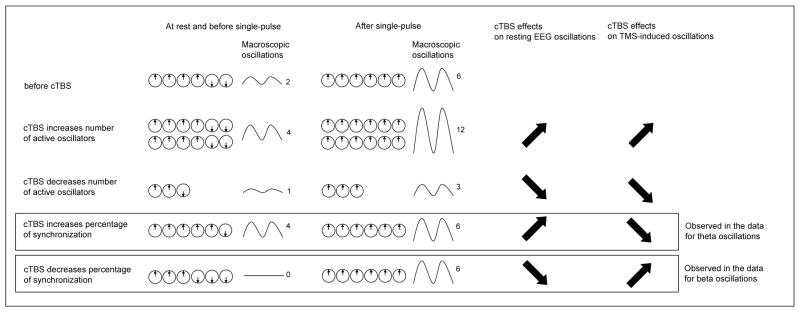Figure 7.

Schematic representation of the hypothetical effects of cTBS on neural oscillators. In this simple representation, oscillators can only be either in a 0° phase or in a 180° phase. In the example described, there are 6 active oscillators before the application of cTBS, 4 with a 0° phase and 2 with a 180° phase, given a macroscopic power of 2 (arbitrary value; line 1, column 1). A single-pulse of TMS is believed to align the phase of these oscillators. In this simple example, we assume that a single-pulse align the phase of all active oscillators, giving a power of 6 (line 1, column 2). Lines 2 to 5 describe the hypothetical cTBS mechanisms. The first hypothetical mechanism is that cTBS modulates the number of active oscillators without modifying the percentage of synchronization between active oscillators (lines 2 & 3). The second hypothetical mechanism is that cTBS modulates the percentage of synchronization between active oscillators without modifying the number of active oscillators (lines 4 & 5). These effects would be directly observed at rest (lines 2–5, column 1) and, by comparison with the pre-cTBS state (line 1, column 1), on the modulation of resting EEG oscillations (lines 2–5, column 3). Then, keeping the assumption that a single-pulse aligns the phase of all active oscillators, we will observe the after single-pulse states described in column 2. The modulation of TMS-induced oscillations (lines 2–5, column 4) can be obtained by comparing the TMS-induced oscillations (lines 2–5, column 2 minus 1) for each hypothesis with pre-cTBS induced oscillations (line 1, column 2 minus 1). The data presented in this study favor the hypothesis that cTBS increases the percentage of synchronization between theta oscillators and decreases the percentage of synchronization between beta oscillators.
